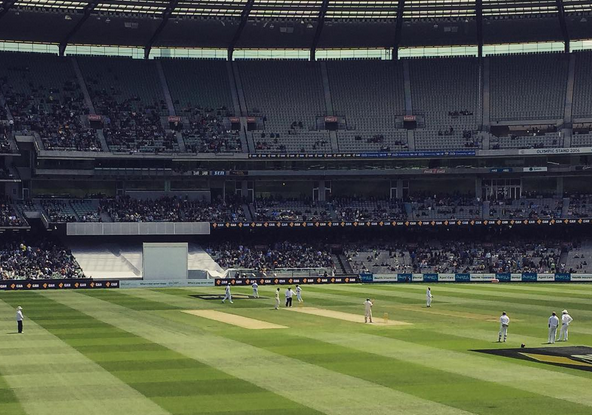

Kraigg Brathwaite – C-
In a test where runs came a bit easier for the West Indies, Kraigg Brathwaite still never looked very comfortable out in the middle.
Innings of 17 and 31 did not impress, yet the 94 he made in Hobart and the general shortage of options on hand for the Windies will mean his spot should be safe.
Rajendra Chandrika – C
For a man who does not have a particularly attractive first-class or test match batting average, Rajendra Chandrika held his own against a hungry Australian attack, in just his third test match.
Innings of 25 and 37 justify the West Indies picking the 26 year-old right-hander, and he’ll look to build on his fair outing in Melbourne by upping the ante in Sydney.
Darren Bravo – B
Undoubtedly the most impressive of the Windies’ batting attack, Darren Bravos’ first innings 81 went a long way to helping his team believe that they could post an impressive total against the Australians.
Whether or not you were impressed by the West Indies’ improved performance, Bravos’ inspirational batting performance worked, with the conglomerate nation posting their best test batting numbers in years.
Marlon Samuels – F
Marlon Samuels was supposed to be the injection of class that the Windies needed in order to at least compete with Australia. He wasn’t.
Fortunately for the Jamaican, his team did well despite him. Innings of 0 and 19 were far from par.
Jermaine Blackwood – C
After Jermaine Blackwood’s disastrous test in Hobart, any score would’ve been an improvement from dual ducks.
His 28 and 20 this time out were nothing to write home about, but the time spent out in the middle scoring runs was good enough for the struggling West Indies.
Denesh Ramdin – B
Denesh Ramdin’s third 50 of 2015 could not have come at a better time, batting sixth for a team that looked like it was about to collapse and in desperate need of an experienced innings.
The 30 year-old wicketkeeper was actually one that outmatched his Australian counterpart with the bat. (By default however, considering Peter Nevill did not get a chance in the middle).
Jason Holder – A-
Jason Holder put in the best all-round performance of the Windies players’ this test, managing 68 runs with the bat and two (out of a total of six) wickets.
They may not look like stats deserving of an a-, but for the way this young man has held his team together and inspired them to be competitive, he gains my plaudits. Bravo, young man.
Carlos Brathwaite – B-
The man on test debut was a worthwhile inclusion, going for 59 late in the order in the second innings after two in the first.
He will surely be included next time around, perhaps higher up the order, after also taking the important wicket of David Warner on 17 in the second.
Kemar Roach – D
The man who was once the great white hope for the West Indian batting attack was basically completely ineffective in a test where wickets were hard to come by for the visitors.
Even worse, he was expensive in both innings, with an economy of 5.7 and 5.5 respectively. But, at least he actually scored some runs this match.
Jerome Taylor – C-
The most experienced Windies bowler was the pick of their attack outside the captain, managing a mighty two wickets.
Considering the West Indians are slowly making their way towards competitiveness, one can naturally assume that the next facet of their game to correct would be bowling. Jerome Taylor is the key to this.
Jomel Warrican – F
So far in Jomel Warrican’s three test matches, his impressive first-class bowling average has not translated well to test matches.
Granted he is facing one of the worlds’ most dangerous batting attacks, a dangerous spinner to dry up runs wouldn’t go amiss in this Windies attack.






